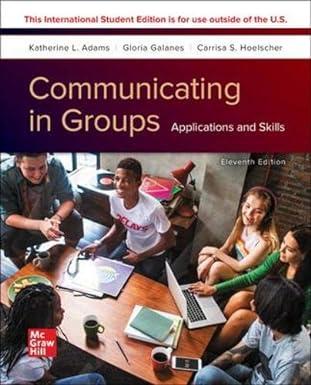Question
1 Explain what leadership is, when leaders are effective and ineffective, and the sources of power that enable managers to be effective leaders. LO10-2 Identify
1 Explain what leadership is, when leaders are effective and ineffective, and the sources of power that enable managers to be effective leaders.
LO10-2 Identify the traits that show the strongest relationship to leadership, the behaviors leaders engage in, and the limitations of the trait and behavioral models of leadership.
LO10-3 Explain how contingency models of leadership enhance our understanding of effective leadership and management in organizations.
LO10-4 Describe what transformational leadership is, and explain how managers can engage in it.
LO10-5 Characterize the relationship between gender and leadership and explain how emotional intelligence may contribute to leadership effectiveness.
LO11-1 Explain why groups and teams are key contributors to organizational effectiveness.
LO11-2 Identify the different types of groups and teams that help managers and organizations achieve their goals.
LO11-3 Explain how different elements of group dynamics influence the functioning and effectiveness of groups and teams.
LO11-4 Explain why it is important for groups and teams to have a balance of conformity and deviance and a moderate level of cohesiveness.
LO11-5 Describe how managers can motivate group members to achieve organizational goals and reduce social loafing in groups and teams.
LO12-1 Explain why strategic human resource management can help an organization gain a competitive advantage.
LO12-2 Describe the steps managers take to recruit and select organizational members.
LO12-3 Discuss the training and development options that ensure organization members can effectively perform their jobs.
LO12-4 Explain why performance appraisal and feedback is such a crucial activity, and list the choices managers must make in designing effective performance appraisal and feedback procedures.
LO12-5 Explain the issues managers face in determining levels of pay and benefits.
LO12-6 Understand the role that labor relations play in the effective management of human resources.
LO13-1 Differentiate between data and information, list the attributes of useful information, and describe three reasons why managers must have access to information to perform their tasks and roles effectively.
LO13-2 Explain why effective communication helps an organization gain a competitive advantage, and describe the communication process.
LO13-3 Define information richness, and describe the information richness of communication media available to managers.
LO13-4 Differentiate among six kinds of management information systems.
LO14-1 Explain the role of operations management in achieving superior quality, efficiency, and responsiveness to customers.
LO14-2 Describe what customers want, and explain why it is so important for managers to be responsive to their needs.
LO14-3 Explain why achieving superior quality in an organization's operations and processes is so important.
LO14-4 Explain why achieving superior efficiency is so important.
Step by Step Solution
There are 3 Steps involved in it
Step: 1
Leadership Leadership is the ability to influence and guide individuals or groups towards achieving a common goal Effective leaders inspire motivate and empower their teams leading to positive outcome...
Get Instant Access to Expert-Tailored Solutions
See step-by-step solutions with expert insights and AI powered tools for academic success
Step: 2

Step: 3

Ace Your Homework with AI
Get the answers you need in no time with our AI-driven, step-by-step assistance
Get Started


